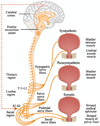Bladder afferent signaling: recent findings
- PMID: 20171668
- PMCID: PMC3686308
- DOI: 10.1016/j.juro.2009.12.060
Bladder afferent signaling: recent findings
Abstract
Purpose: Much current research on lower urinary tract physiology focuses on afferent mechanisms. The main goals are to define and control the signaling pathways by which afferent information is generated and conveyed to the central nervous system. We summarize recent research on bladder afferent mechanisms.
Materials and methods: We systematically reviewed the literature by searching PubMed up to June 2009 with focus on the last 5 years.
Results: At least 2 signaling pathways can be identified, including the urothelial and the myogenic pathway. The urothelial pathway is a functional unit consisting of the urothelium, interstitial cells and afferent nerves in the lamina propria. Signaling occurs via muscle-mucosal mechanoreceptors, mucosal mechanoreceptors and chemoreceptors. The myogenic pathway is activated via in-series mechanoreceptors responding to distention and via spontaneous contractile activity in units of myocytes generating afferent noise.
Conclusions: To control dysfunctional micturition we must know more about all components involved in normal micturition control, including how afferent information is handled by the central nervous system.
Copyright (c) 2010 American Urological Association Education and Research, Inc. Published by Elsevier Inc. All rights reserved.
Figures




Similar articles
-
Afferent mechanism in the urinary tract.Handb Exp Pharmacol. 2011;(202):171-205. doi: 10.1007/978-3-642-16499-6_9. Handb Exp Pharmacol. 2011. PMID: 21290227 Review.
-
Mechanisms of pelvic organ cross-talk: 2. Impact of colorectal distention on afferent nerve activity of the rat bladder.J Urol. 2013 Sep;190(3):1123-30. doi: 10.1016/j.juro.2013.03.079. Epub 2013 Mar 28. J Urol. 2013. PMID: 23542407
-
Researching bladder afferents-determining the effects of β(3) -adrenergic receptor agonists and botulinum toxin type-A.Neurourol Urodyn. 2011 Jun;30(5):684-91. doi: 10.1002/nau.21102. Neurourol Urodyn. 2011. PMID: 21661014 Review.
-
Integrative control of the lower urinary tract: preclinical perspective.Br J Pharmacol. 2006 Feb;147 Suppl 2(Suppl 2):S25-40. doi: 10.1038/sj.bjp.0706604. Br J Pharmacol. 2006. PMID: 16465182 Free PMC article. Review.
-
Properties of the major classes of mechanoreceptors in the guinea pig bladder.J Physiol. 2007 Nov 15;585(Pt 1):147-63. doi: 10.1113/jphysiol.2007.140244. Epub 2007 Oct 4. J Physiol. 2007. PMID: 17916614 Free PMC article.
Cited by
-
Mirabegron in the Management of Overactive Bladder Syndrome.Int J Womens Health. 2022 Sep 16;14:1337-1350. doi: 10.2147/IJWH.S372597. eCollection 2022. Int J Womens Health. 2022. PMID: 36147890 Free PMC article. Review.
-
A pilot study to measure dynamic elasticity of the bladder during urodynamics.Neurourol Urodyn. 2017 Apr;36(4):1086-1090. doi: 10.1002/nau.23043. Epub 2016 May 31. Neurourol Urodyn. 2017. PMID: 27241067 Free PMC article.
-
Sleeping beauty: awakening urothelium from its slumber.Am J Physiol Renal Physiol. 2017 Apr 1;312(4):F732-F743. doi: 10.1152/ajprenal.00337.2016. Epub 2017 Jan 25. Am J Physiol Renal Physiol. 2017. PMID: 28122714 Free PMC article. Review.
-
Differential functional brain network connectivity during visceral interoception as revealed by independent component analysis of fMRI TIME-series.Hum Brain Mapp. 2015 Nov;36(11):4438-68. doi: 10.1002/hbm.22929. Epub 2015 Aug 7. Hum Brain Mapp. 2015. PMID: 26249369 Free PMC article.
-
Alteration in TRPV1 and Muscarinic (M3) receptor expression and function in idiopathic overactive bladder urothelial cells.Acta Physiol (Oxf). 2013 Jan;207(1):123-9. doi: 10.1111/j.1748-1716.2012.02462.x. Epub 2012 Jul 12. Acta Physiol (Oxf). 2013. PMID: 22691178 Free PMC article.
References
-
- Andersson KE, Arner A. Urinary bladder contraction and relaxation: physiology and pathophysiology. Physiol Rev. 2004;84:935. - PubMed
-
- Drake MJ, Mills IW, Gillespie JI. Model of peripheral autonomous modules and a myovesical plexus in normal and overactive bladder function. Lancet. 2001;358:401. - PubMed
-
- Yoshimura N, Kaiho Y, Miyazato M, et al. Therapeutic receptor targets for lower urinary tract dysfunction. Naunyn Schmied Arch Pharmacol. 2008;377:437. - PubMed
-
- Wakabayashi Y, Tomoyoshi T, Fujimiya M, et al. Substance P-containing axon terminals in the mucosa of the human urinary bladder: pre-embedding immunohistochemistry using cryostat sections for electron microscopy. Histochemistry. 1993;100:401. - PubMed
Publication types
MeSH terms
Grants and funding
LinkOut - more resources
Full Text Sources
Other Literature Sources
Medical

